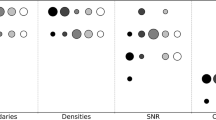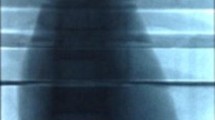Abstract
In paediatric radiology it has been recognised that children have a higher risk of developing cancer from the irradiation than adults (two to three times); therefore, increased attention has been directed towards the dose to the patient. In this study the effect on patient dose and image quality in replacing the exposure in micturating cystourethrography (MCUG) examinations with the stored fluoroscopy image has been investigated. In the intravenous urography (IVU) examination we compared analogue and digital image quality, but the dose measurements were performed on a phantom. Standard clinical X-ray equipment was used. Sixty-eight patients in each of two centres were studied for the MCUG. Doses were measured with a dose-area product (DAP) meter and the image quality was scored. A non-parametric statistical analysis was performed. For the IVU, a phantom was used in the dose measurements but clinical images were scored in the comparison between analogue and digital images. For the MCUG, replacing the exposure with stored fluoroscopy images lowered the DAP value from 0.77 to 0.50 Gy cm2. The image quality did not show any difference between the techniques; however, if reflux was to be graded, exposure was needed. For the IVU, the doses could be lowered by a factor of 3 using digital techniques. The image quality showed no statistical difference between the two techniques. There is a potential for a substantial dose reduction in both MUCG and IVU examinations using digital techniques.
Similar content being viewed by others
References
Fendel H, Schneider K, Kohn MM, Bakowski C (1989) Specific principles for optimization in image quality and patient exposure in paediatric diagnostic imaging. BIR Rep 20:91–101
European Guidelines on Quality Criteria for Diagnostic Radiograpic Images in Paediatrics (1996) EUR 16261 EN, Luxembourg, ISBN 92-827-7843-6
ICRP 60 (1991) Recommendations of the International Commission of Radiological Protection. Pergamon Press, Oxford
Hallén S, Martling K, Mattsson S (1992) Dosimetry at X-ray examinations of scoliosis. Radiat Prot Dosim 43:49–54
Gallini RE, Belletti S, Berna V, Guigni U (1992) Adult and child doses in standardised X-ray examinations. Radiat Prot Dosim 43:41–49
Schneider K, Fendel H, Bakowski C, Stein E, Kohn M, Kellner M, Schweighofer K, Cartagena G, Padovani R, Panzer W, Scheurer C, Wall B (1992) Results of a dosimetric study in the European community on frequent X-ray examinations in infants. Radiat Prot Dosim 43:31–36
Almén A (1995) Radiation dose to children in diagnostic radiology. Measurements and methods for clinical optimisation studies. Doctoral Dissertation, Department of Radiation Physics, Malmö University Hospital, Malmö, Sweden
Reuter FG, Conway BJ, McCrohan JL, Slayton RJ, Suleiman OH (1992) Assessment of skin entrance kerma in the United States: the nationwide evaluation of X ray trends (NEXT). Radiat Prot Dosim 43:71–73
Supe SJ, Iyer PS, Sasane JB, Sawant SG, Shirva VK (1992) Estimation and significance of patient doses from diagnostic X ray practises in India. Radiat Prot Dosim 43:209–211
Maruyama T, Kumamoto Y, Noda Y, Iwai K, Mase N, Nishizawa K, Furuya Y (1992) Determinations of organ or tissue doses and collective effective dose equivalent from diagnostic X-ray examinations in Japan. Radiat Prot Dosim 43:213–216
Nicholson RA, Thornton A, Akpan M (1995) Radiation dose reduction in paediatric fluoroscopy using added filtration. Br J Radiol 68:296–300
Gonzalez L, Vano E, Ruiz MJ (1995) Radiation doses to paediatric patients undergoing micturating cystourethrography examinations and potential reduction by radiation protection optimization. Br J Radiol 68:291–295
Hansson B, Finnbogason T, Schuwert P, Persliden J (1997) Added copper filtration in pediatric double-contrast colon examinations: effects on radiation dose and image. Eur Radiol 7:1117–1122
Persliden J, Petterson HBL, Fälth-Magnusson K (1996) Radiation dose at small intestinal biopsies in children: results of a national study. Acta Paediatr 85:1042–1046
Geijer H, Verdonck B, Beckman KW, Andersson T, Persliden J (2003) Digital radiography of scoliosis with a scanning method: radiation dose optimisation. Eur Radiol 13:543–551
Persliden J, Beckman KW, Geijer H, Andersson T (2002) Dose-image optimisation in digital radiology with a direct digital detector: an example applied to pelvic examinations. Eur Radiol 12:1584–1588
Almen A, Mattsson S (1995) The radiation dose to children from X-ray examinations of the pelvis and the urinary tract. Br J Radiol 68:604–613
Smith T, Gordon I, Kelly JP (1998) Comparison of radiation dose from intravenous urography and99Tcm-DMSA scintigraphy in children. Br J Radiol 71:314–319
Vestergren E (1998) Administered radiopharmaceutical activity and radiation dosimetry in paediatric nuclear medicine. Thesis, Department of Radiation Physics, Gothenburg University, Gothenburg, Sweden, ISBN 91-628-2951-3
Acknowledgement
This work was founded by The FORSS Foundation contract no. F96–134.
Author information
Authors and Affiliations
Corresponding author
Rights and permissions
About this article
Cite this article
Persliden, J., Helmrot, E., Hjort, P. et al. Dose and image quality in the comparison of analogue and digital techniques in paediatric urology examinations. Eur Radiol 14, 638–644 (2004). https://doi.org/10.1007/s00330-003-2144-9
Received:
Revised:
Accepted:
Published:
Issue Date:
DOI: https://doi.org/10.1007/s00330-003-2144-9




